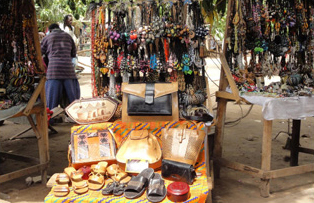

African art comes in the most wonderful abstract forms, from paintings to murals to sculptures and wood carvings. Hand woven cloth, batiks, and mudc loth can be made into soft furnishings or designed into unique high fashion clothing. The textures and designs are underused in the western world, but in Africa the rich vibrant colours are used in the exotic clothes which are also embroidered with wonderful original designs. It is possible to identify the country of origin of traditional by the style and use of material.
Tie-Dye, Waxes & Damask Cloths: melted beeswax is mixed with paraffin and applied to the fabric using a variety of techniques. It can be poured, painted on using a brush or applied to pre-carved wooden or metal wire blocks which are used to stamp the fabric. Thin lines can created using a canting, a wooden handled tool with a tiny metal cup and spout, from which the wax can seep. While the wax binds to the fabric the paraffin will crack. The fabric is then dipped in dye. Several dyes may be used to colour different areas. After the final dyeing the fabric is hung up to dry and then either dipped in a solvent to dissolve the wax, or ironed between paper towels or newspapers to absorb the wax, revealing the deep rich colors and the fine crinkle lines that give batik its characteristic look. Gambian tie-dye and batiks are extravagant and rich in colour and are often seen at tourist mar-kets as art or tailored into men’s Kaftans (haftans), women’s Yara, or warambas (grandmubas), skirts, shirts, blouses, bedsheets, curtains and tablecloths.
Mudcloth or bògòlanfini is a traditional Malian fabric dyed with fermented mud, particularly associated with the Bambara. Bògòlanfini is a Bambara word meaning “earthcloth.” To create it, simple cotton cloth is woven, shrunk, and then soaked in a preparation of leaves from certain trees. An artist then outlines an intricate design, often taking several weeks to cover the entire cloth, with a mud dye. The areas of yellowish mud are then treated with caustic soda, bleaching them white and creating a stark black and white design. Traditionally, a man will do the weaving while a woman will do the dyeing. In recent years, fashion designers such as Chris Seydou have employed bògòlanfini in international clothing lines, while Malian painter Ishmael Diabate has developed it as a fine art form.
Wooden masks, human, animal or some mythical creature, are one of the most common forms of art in western Africa. In their original context, masks were worn by a chosen or initiated dancer and used for celebrations, initiations, crop harvesting, and war preparation. During a mask ceremony the dancer goes into deep trance, and while in this state, “communicates” with his ancestors. Masks can be worn in three ways: vertically covering the face: as a helmet, encasing the entire head, and as a crest, resting upon the head usually covered by material as part of the disguise. African masks often represent a spirit and it is strongly believed that the spirit of the ancestors possesses the wearer.